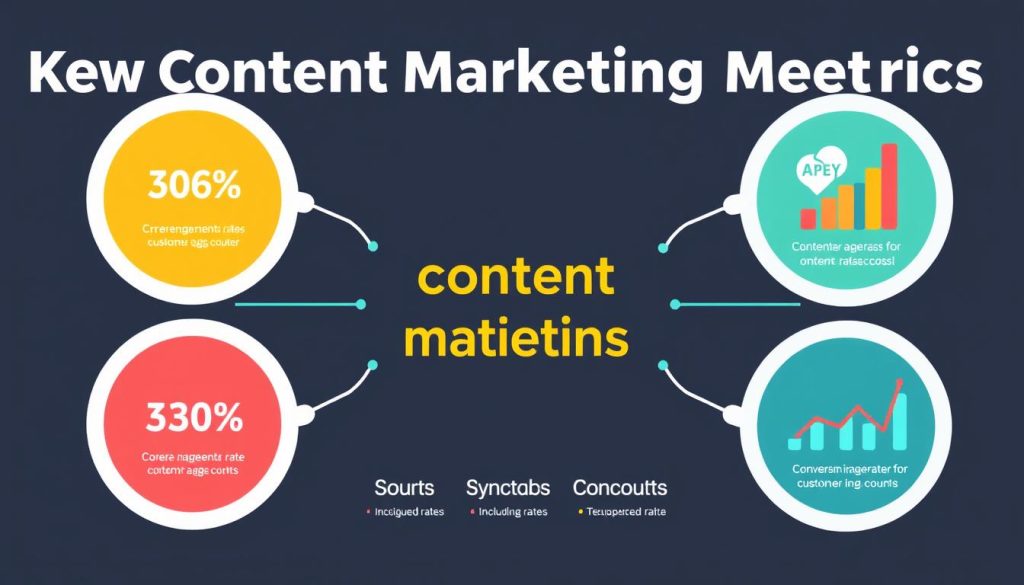We’re entering a new era in content marketing, where measurable results drive every decision and strategy. In today’s data-driven business landscape, understanding how to measure and optimize content performance is no longer optional—it’s essential for survival and growth.
By focusing on tangible outcomes rather than just creative execution, we can transform traditional approaches and deliver real business results. Our goal is to help you build a content strategy that justifies its existence through clear ROI and measurable impact.
Key Takeaways
- Understand the importance of measurable results in content marketing.
- Learn how to set up measurement frameworks that connect content to revenue.
- Discover the metrics that matter most for content performance.
- Improve your content’s performance continuously.
- Build a content strategy with clear ROI and measurable impact.
Understanding Performance Content Marketing
Performance content marketing is revolutionizing the way businesses approach their content strategies. We’re witnessing a significant shift in how companies create and distribute content, with a growing emphasis on measurable outcomes rather than just creative output.
What Is Performance Content Marketing?
Performance content marketing refers to advertising programs where affiliates and marketing companies are paid only when a desired action is completed, such as a sale, lead, or download. This approach ties every piece of content to specific, trackable business objectives and conversion metrics. By doing so, it demands accountability through direct impact on revenue and business growth.
At its core, performance content marketing integrates advertising principles with content strategy, creating hybrid approaches that leverage the strengths of both disciplines. This results in a more effective use of marketing efforts, driving tangible results for businesses.
How Performance Content Marketing Differs from Traditional Content Marketing
Unlike traditional content marketing, which often prioritizes brand awareness and engagement, performance content marketing focuses on driving conversions and sales. The key distinction lies in the measurement approach: while traditional content marketing struggles to connect efforts to business outcomes, performance content marketing establishes clear cause-and-effect relationships.
This approach transforms content from a cost center to a profit center by creating direct pathways from content consumption to customer action. As a result, businesses can scale their marketing strategies more effectively, achieving predictable and scalable results.
The Value of Performance Content Marketing in Today’s Digital Landscape
In the rapidly evolving digital landscape, performance content marketing has emerged as a crucial strategy for businesses seeking measurable results. As we navigate through the complexities of digital marketing, it’s becoming increasingly clear that traditional approaches are no longer sufficient.
The digital advertising landscape is witnessing a significant shift, with worldwide spending projected to reach $646 billion by 2024, up from $455.3 billion in 2021. This surge underscores the growing importance of performance content marketing, which delivers measurable value that traditional methods struggle to match.
Key Benefits for Businesses
Performance content marketing offers several key benefits for businesses. It provides trackable performance, allowing brands to monitor the entire customer journey from click to conversion. This approach also enables businesses to reach their target audience more effectively, enhancing brand awareness among the right demographics.
- Measurable ROI through direct accountability
- Targeted brand awareness through affiliates and agencies
- Lower risk due to performance-based payment structures
As shown in the table below, the benefits of performance content marketing are multifaceted, offering businesses a competitive edge in today’s digital landscape.
| Benefits | Traditional Marketing | Performance Content Marketing |
|---|---|---|
| Measurability | Limited tracking capabilities | Direct accountability and measurable ROI |
| Risk Level | Higher risk due to upfront costs | Lower risk with performance-based payments |
| Targeting | Broad, less targeted approach | Targeted approach through affiliates and agencies |

Why Performance-Driven Content Is Essential for ROI
Performance-driven content is crucial for achieving a strong Return on Investment (ROI). By directly connecting content investments to revenue generation, businesses can validate their marketing expenditures with concrete data.
This data-driven approach not only justifies marketing spend but also informs future content strategies, creating a virtuous cycle of continuous improvement. As a result, businesses can optimize their marketing efforts for better results, driving growth and profitability.
Setting Clear Goals for Your Performance Content Strategy
Establishing a robust performance content strategy begins with setting clear, measurable goals that align with your business objectives. Without these goals, your content creation efforts risk being aimless and ineffective.
Defining Measurable Objectives
To ensure clarity and accountability in your content marketing efforts, we advocate for the SMART framework when establishing content objectives. This means your goals should be Specific, Measurable, Achievable, Relevant, and Time-bound. By doing so, you create a roadmap for your content that is focused and achievable.
For instance, instead of having a vague goal like “increase website traffic,” a SMART objective would be “boost organic website traffic by 20% within the next 6 months through targeted content marketing campaigns.” This clarity helps in aligning the team’s efforts toward a common objective.
Aligning Content Goals with Business Outcomes
Your content goals must directly connect to broader business outcomes, whether that’s lead generation, sales conversion, customer retention, or brand authority. Establishing clear KPIs that everyone on the team understands is crucial for the success of your performance content strategy.
Documenting your content goals not only creates alignment across departments but also ensures that your marketing efforts support broader business objectives. Regular reviews of these goals, at least quarterly, allow for strategic adjustments based on performance data and changing business priorities.
| Business Outcome | Content Goal | Metric for Success |
|---|---|---|
| Lead Generation | Increase gated content downloads by 30% | Conversion rate on landing pages |
| Sales Conversion | Boost sales-qualified leads by 25% | Lead-to-customer conversion rate |
| Brand Authority | Enhance thought leadership pieces by 40% | Engagement metrics on thought leadership content |
“The key to successful content marketing lies in setting clear, measurable goals that are aligned with your business objectives. Without this alignment, your content efforts are likely to be misdirected and ineffective.”

Identifying and Understanding Your Target Audience
A deep understanding of your target audience is the foundation of any effective content marketing strategy. To create content that resonates and drives results, you need to know who you’re trying to reach with your content. By taking the time to understand your audience and what they’re looking for, you can ensure that your content marketing efforts are always on target.
Creating Detailed Audience Personas
We don’t just stop at basic demographics when creating personas; we dig deeper to capture psychographic factors, pain points, objections, and decision-making processes. This detailed understanding allows us to craft content that speaks directly to our audience’s needs. Detailed audience personas are essential for developing a marketing strategy that truly connects with your target audience.
Mapping Content to the Customer Journey
The most effective content marketing strategy maps different content types to specific stages of the customer journey—from awareness through consideration to decision and loyalty. By analyzing which content resonates with specific audience segments, you can create more targeted, high-performing content that drives measurable results for your company website and increases traffic. This approach enables you to position your brand as a trusted resource throughout the customer’s journey.
| Stage of Customer Journey | Content Type | Goal |
|---|---|---|
| Awareness | Blog Posts, Social Media | Introduce Brand |
| Consideration | Case Studies, Whitepapers | Build Credibility |
| Decision | Product Demos, Trials | Drive Conversion |
As marketing expert Joe Pulizzi once said, “Content marketing is the only marketing left.” This emphasizes the importance of understanding your audience and creating content that resonates with them.
“The best marketing doesn’t feel like marketing.”

Essential Components of Successful Performance Content Marketing
Achieving success in performance content marketing involves combining several crucial components effectively. Successful performance content marketing requires strategic integration of multiple components—from content types to distribution channels to measurement frameworks.
To drive performance metrics, it’s essential to understand the types of content that resonate with your audience. We’ve identified several content formats that consistently drive performance: data-driven research, solution-oriented guides, comparison content, and decision-support tools.
Content Types That Drive Performance
Data-driven research is particularly effective as it provides valuable insights that attract and engage your target audience. Solution-oriented guides help potential customers navigate complex problems, establishing your brand as a trusted authority. Comparison content allows consumers to make informed decisions, while decision-support tools facilitate the buying process.
By incorporating these content types into your strategy, you can significantly enhance your performance content marketing efforts. The key is to create content that guides the reader toward a logical next step, creating clear pathways to conversion.
| Content Type | Description | Performance Impact |
|---|---|---|
| Data-driven Research | Provides valuable insights and statistics | Attracts and engages target audience |
| Solution-oriented Guides | Helps navigate complex problems | Establishes brand authority |
| Comparison Content | Facilitates informed decision-making | Enhances customer understanding |
| Decision-support Tools | Simplifies the buying process | Drives conversions |
Distribution Channels for Maximum Impact
Distribution strategy is equally important as content creation. A multi-channel approach typically outperforms single-channel distribution, with social media, search, email, and strategic partnerships forming the core of most successful strategies.
By leveraging these distribution channels effectively, you can amplify your content’s reach and impact. For instance, social media marketing allows for targeted promotion, while search marketing enhances visibility among potential customers actively seeking related information.

Content amplification through paid promotion can significantly boost performance metrics when targeted precisely to your ideal audience segments. Regular content audits help identify which content types and distribution channels deliver the strongest performance, allowing for strategic resource allocation.
Implementing a Data-Driven Content Creation Process
Data-driven content creation is the key to unlocking the full potential of performance content marketing. By leveraging data insights, businesses can develop a content creation process that yields predictable, scalable results.

Research and Planning Techniques
A research-first approach is essential for effective content creation. This involves conducting keyword analysis, competitive content audits, and audience intent mapping before starting content creation. By doing so, businesses can create content that resonates with their target audience and drives performance.
As emphasized by industry experts, “A data-driven content creation process transforms content marketing from an art to a science—producing predictable, scalable results.” This approach enables businesses to refine their content strategy over time by incorporating performance data from previous content.
- Conduct thorough keyword analysis to identify relevant topics and search trends.
- Perform competitive content audits to understand the competitive landscape.
- Create detailed audience personas to guide content creation.
Content Production Best Practices
To maximize the effectiveness of content production, businesses should balance creative excellence with performance optimization. This includes incorporating SEO best practices, conversion elements, and distribution considerations from the start.
Regular performance reviews during the production process allow for strategic adjustments based on real-time data. By adopting a test-and-learn approach, businesses can systematically test content variations to identify the most effective approaches for their specific audience.
Key elements of successful content production include:
- Incorporating SEO best practices to enhance search engine visibility.
- Using conversion elements to drive desired actions.
- Considering distribution channels to maximize content reach.
Key Metrics to Measure Performance Content Marketing Success

The key to unlocking performance content marketing success lies in selecting the most relevant metrics. With numerous metrics available, it’s essential to choose those that align with your goals.
Engagement Metrics
Engagement metrics measure audience interest and include indicators such as time on page, scroll depth, return visits, and social sharing. These metrics help you understand how your content resonates with your audience.
For instance, if your goal is to increase website traffic, you’ll want to track pageviews and unique visitors. High engagement metrics can indicate that your content is relevant and effective.
Conversion Metrics
Conversion metrics directly connect content to business outcomes through lead generation, email sign-ups, demo requests, and sales. These metrics are crucial in measuring the ultimate performance of your content.
By tracking conversion metrics, you can determine whether your content is driving the desired leads and sales. This helps you refine your content strategy to achieve better results.
ROI Metrics
ROI metrics calculate the financial return of your content investment through customer acquisition cost, lifetime value attribution, and revenue generated per content piece. These metrics help you understand the financial impact of your content marketing efforts.
By analyzing ROI metrics, you can determine whether your content is generating a positive return on investment and make data-driven decisions to optimize your content strategy for better ROI.
Optimizing Your Content for Better Performance
To maximize the effectiveness of your content marketing strategy, optimizing your content for better performance is crucial. This involves a systematic approach to improve how your content resonates with your target audience and drives desired actions.
A/B Testing Strategies
A/B testing, or split testing, is a powerful method to compare different versions of your content and determine which one performs better. By testing variables such as headlines, formats, calls-to-action, and content structures, you can gain valuable insights into what works best for your audience. We approach A/B testing as an ongoing discipline, continuously refining our content to achieve better results. This involves testing different elements to understand their impact on performance.
For instance, testing different headlines can reveal which ones capture more attention, while testing calls-to-action can show which ones drive more conversions. The key is to be systematic and data-driven in your approach, using the insights gained to inform your content strategy.

Content Refinement Based on Analytics
Analytics-based refinement is about looking beyond surface-level metrics to understand the underlying reasons for your content’s performance. By analyzing data, you can identify patterns and insights that inform strategic adjustments to your content. Content that initially underperforms can become a high-converting asset after several rounds of data-driven optimization.
Implementing a regular content refresh schedule, where existing assets are updated based on performance data, can extend their lifecycle and improve ROI.
“The compound effect of continuous optimization creates exponential performance improvements over time—small percentage gains accumulate into significant business impact.”
This approach ensures that your content remains relevant and effective over time.
Building a Performance Content Marketing Team
To drive results-driven content marketing, assembling the right team with the right mix of skills is essential. A high-performing team is the cornerstone of any successful performance content marketing strategy, enabling businesses to achieve their goals in a competitive digital landscape.
The complexity of content marketing demands a diverse set of skills. We’ve identified that a blend of creative, analytical, and technical skills working in harmony is critical for success. This involves strategists who set direction, creators who produce assets, analysts who measure results, and optimizers who refine performance.
Essential Roles and Responsibilities
A successful content marketing team comprises various essential roles. Strategists are responsible for setting the overall direction and aligning content with business objectives. Creators produce high-quality content that resonates with the target audience. Analysts measure the performance of the content, providing insights that inform future content decisions. Optimizers use these insights to refine and improve content performance over time.
Establishing clear processes for collaboration is vital. This includes defined workflows that connect strategy, creation, distribution, and measurement. By doing so, teams can ensure that their content marketing strategy is cohesive and effective.
In-House vs. Outsourced Content Creation
The decision between in-house and outsourced content creation isn’t binary. Most successful programs use a hybrid approach, leveraging internal knowledge with specialized external expertise. In-house teams excel at brand alignment and institutional knowledge, while agency partners bring specialized skills, broader perspective, and scalable resources.
By combining the strengths of both in-house and outsourced teams, businesses can create a robust content marketing program that drives results. Regular skill development is also essential, as performance content marketing evolves rapidly, requiring ongoing training in analytics, SEO, conversion optimization, and emerging content formats.
Advanced Strategies from Industry Experts
The key to unlocking exceptional performance in content marketing lies in implementing sophisticated, data-driven strategies. To help businesses achieve this, we’ve gathered insights from top industry experts on the most effective approaches to content marketing.
Case Studies of Successful Performance Content Campaigns
Our analysis of dozens of successful performance content campaigns across various industries has revealed common patterns and principles that drive exceptional outcomes. Case studies show that the most effective campaigns combine deep audience insights, strategic distribution, and systematic optimization. For instance, a well-known brand in the technology sector saw a significant increase in engagement by tailoring their content to specific audience segments and leveraging social media platforms for distribution.
These successful campaigns demonstrate the importance of integrating multiple elements to achieve performance goals. By understanding their target audience and creating content that resonates with them, businesses can drive meaningful marketing results.
Expert Tips for Scaling Your Content Performance
To scale content performance, industry experts recommend building systems rather than creating one-off pieces. This involves establishing repeatable processes that can be executed consistently across topics and campaigns. One effective approach is content atomization, which involves creating modular content that can be reconfigured and repurposed across channels and formats.
Additionally, implementing a formal testing program can help unlock new performance breakthroughs. By allocating a small percentage of the content marketing budget to experimental formats and approaches, businesses can identify innovative strategies that drive results.
Conclusion: Future-Proofing Your Performance Content Marketing Strategy
The key to unlocking the full potential of performance content marketing lies in embracing a cyclical and iterative process. To future-proof your strategy, you must build adaptability into your approach, creating systems that can evolve with changing technologies and audience behaviors.
We view performance content marketing as an ongoing cycle rather than a linear process—continuously learning, adjusting, and improving based on real-world results. By doing so, you’ll be able to balance proven tactics with strategic experimentation, allocating resources to both optimize what works and discover new opportunities.
By implementing these strategies, you’ll build a performance content marketing program that delivers measurable business results today while positioning your brand for continued success tomorrow.
